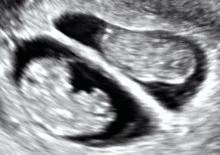Echogenicity
This article needs additional citations for verification. (July 2010) |

Echogenicity (misspelled sometimes as echogenecity) or echogeneity is the ability to bounce an echo, e.g. return the signal in
medical ultrasonography. In contrast, tissues with lower echogenicity are called "hypoechogenic" and are usually represented with darker colors. Areas that lack echogenicity are called "anechogenic" and are usually displayed as completely dark.[1]
Microbubbles
Echogenicity can be increased by intravenously administering gas-filled microbubble contrast agent to the systemic circulation, with the procedure being called
Heavy gases are less water-soluble so they are less likely to leak out from the microbubble to impair echogenicity (McCulloch et al., 2000). Therefore, microbubbles with heavy gas cores are likely to last longer in circulation.Reasons for higher echogenicity
During ultrasound examinations, sometimes echogenicity is higher in certain parts of body.
Fatty liver could cause increased echogenicity in the liver, especially if the liver transaminases are elevated.[3]
Women with polycystic ovary syndrome may also show an increase in stromal echogenicity.
